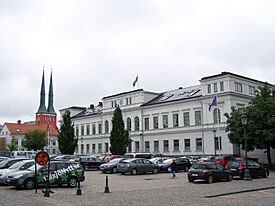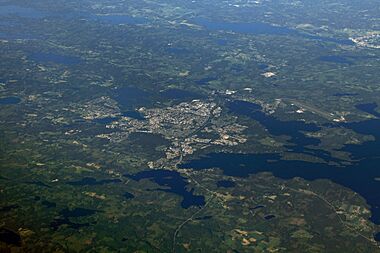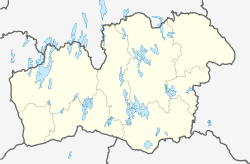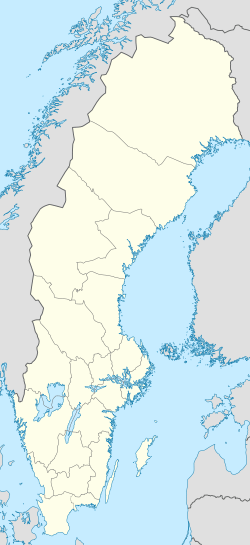Växjö facts for kids
Quick facts for kids
Växjö
|
||
|---|---|---|
|
City
|
||
 |
||
|
||
| Motto(s):
Europe's Greenest City
|
||
| Country | ||
| Province | ||
| County | Kronoberg County | |
| Municipality | Växjö Municipality | |
| Area | ||
| • City | 30.28 km2 (11.69 sq mi) | |
| Elevation | 167 m (548 ft) | |
| Population
(5 September 2017)
|
||
| • City | 66,275 | |
| • Density | 2,011/km2 (5,210/sq mi) | |
| • Metro | 90,721 | |
| Time zone | UTC+1 (CET) | |
| • Summer (DST) | UTC+2 (CEST) | |
| Postal code |
35x xx
|
|
| Area code(s) | (+46) 470 | |
Växjö (pronounced "Vek-shuh") is a city in Sweden. It is the main city of Växjö Municipality in Kronoberg County. In 2019, about 70,489 people lived there. Växjö is an important center for culture, business, and government in Kronoberg County. It is also home to Växjö Cathedral and Linnaeus University.
Contents
What's in a Name?
The name Växjö likely comes from two Swedish words: väg (meaning "road") and sjö (meaning "lake"). This suggests a road that crossed the frozen Växjö Lake. Farmers probably used this road in winter to reach the marketplace. This marketplace later grew into the city we know today.
A Look Back in Time
Växjö has a long history. It became an important religious center in the 11th century. The city officially received its city charter in 1342 from King Magnus Eriksson.
The beautiful Växjö Cathedral was built around the year 1300. It has been repaired and updated many times since then. In the Middle Ages, Växjö also had a Franciscan monastery, built in 1485. A hospital was first mentioned in 1318.
Växjö got its first school, Växjö katedralskola, in the 14th century. This school later became a gymnasium (a type of high school) in 1643.
Fires and Rebuilding
Växjö has faced many fires throughout its history. Fires happened in 1277, 1516, 1570, 1612, 1658, 1690, 1749, 1753, 1799, 1838, and 1843. After the last big fire in 1843, many people lost their homes. The city was then rebuilt with the street plan you see today.

Famous Buildings
Växjö has several interesting old buildings.
Växjö Cathedral
The Växjö Cathedral is a key landmark. It stands proudly near the city center.
Kronoberg Castle
Just north of Växjö, you can find Kronoberg Castle. This is a ruined fortress from the 15th century. It has thick walls and openings for artillery. The rebel leader Nils Dacke used this castle during the Dacke War.
Teleborg Castle
Teleborg Castle is another impressive building near the city. It was built in 1900. Today, it serves as a hotel and a place for conferences. It is also close to Linnaeus University.
What to See and Do
Växjö offers several attractions and services.
Swedish Emigrant Institute
The Swedish Emigrant Institute opened in 1965. It is located near Växjö Lake. This institute has archives, a library, and a museum. It focuses on the time between 1846 and 1930. During this period, many Swedes moved to other countries, especially the United States. You can find old records here, like birth and death records.
Local Businesses
Växjö has several important industries. These include companies like GE Power and Aerotech Telub. Volvo Articulated Haulers is also nearby in Braås. Well-known service companies like Fortnox and Visma are also based here.
Växjö is known as the "Kingdom of Crystal" capital. It also calls itself the "Kingdom of Furniture". The city is home to Sweden's National Glass Museum. Växjö Linnaeus Science Park helps new businesses grow. They focus on green economy, smart city ideas, forestry, and digital technology.
Learning in Växjö
The city has three public high schools: Teknikum, Katedralskolan, and Kungsmadskolan. Linnaeus University is a large university. In 2012, it had about 42,000 students across its campuses.
How People Live Here
Växjö's population has grown steadily over the years.
| Historical population | |||||||||||||||||||||||||||||||||||||||||||||||||
|---|---|---|---|---|---|---|---|---|---|---|---|---|---|---|---|---|---|---|---|---|---|---|---|---|---|---|---|---|---|---|---|---|---|---|---|---|---|---|---|---|---|---|---|---|---|---|---|---|---|
|
|
||||||||||||||||||||||||||||||||||||||||||||||||
Getting Around
Växjö is well-connected by transport.
Trains
The Coast to Coast railway line runs through Växjö. You can take long-distance trains to cities like Gothenburg and Kalmar. Regional trains also connect Växjö to Jönköping. A new city hall and railway station building was finished in 2021.
Roads
Several main roads meet in Växjö. These include roads 23, 25, 27, 29, 30, and 37.
Air Travel
For air travel, Växjö is served by the nearby Växjö/Kronoberg Airport.
A Green City
Växjö is famous for its commitment to the environment.
Aiming for a Fossil Fuel-Free Future
In 1996, the city decided to stop using fossil fuels by 2030. This decision was made to help clean up the lakes around the town. From 1993 to 2015, the city cut its greenhouse gas emissions by 55%. This happened even while the city's economy grew!
Växjö uses smart ways to become fossil fuel-free. For example, waste from local forests is burned to create energy. More than 90% of the energy used for heating comes from trees. Public transport uses biogas and other renewable energy sources. The city also encourages cycling. New buildings are made from wood and designed to save energy.
By 2014, Växjö's carbon dioxide emissions were very low. They were 2.4 tonnes per person. This is much lower than the average for the EU, which was 7.3 tonnes.
Europe's Greenest City
Since 2007, Växjö has called itself "The Greenest City in Europe." This is because of its long history of caring for the environment. The city has big goals for a green future. Citizens and local companies share this vision.
In 2017, Växjö won the European Green Leaf Award 2018. The European Commission gives this award to smaller cities. It recognizes cities that show great results and goals for the environment. It also celebrates cities that create green growth.
Famous People from Växjö
- Jonas Björkman, a tennis player with many titles
- Karl-Birger Blomdahl, a music composer
- Stefan Johansson, a Formula 1 racing driver
- Jonas Jonasson, a writer
- Carolina Klüft, an Olympic gold medalist in track and field
- Pär Lagerkvist, an author who won the Nobel Prize in Literature
- Carl Linnaeus, a famous botanist and scientist
- Christina Nilsson, a well-known singer from the 19th century
- Thomas Ravelli, a famous football goalkeeper
- Mats Wilander, a tennis player with seven Grand Slam wins
- The Ark, a rock band
Sports and Fun
Växjö has many sports clubs for different activities:
- Östers IF – football
- Hovshaga AIF – football, floorball, and tennis
- Växjö BK – football
- Växjö Lakers – ice hockey
- Växjö Vipers – floorball
- Wexjö RK – rugby
- Växjö Ravens BBK - basketball
- Växjö OK – orienteering
- Växjö DFF – football
- Växjö United FC – football
- Växjö VK – Volleyball
Weather in Växjö
Växjö has a climate that is milder and wetter than many other parts of Sweden. It also tends to be cloudier. Winters are relatively mild for an inland city. Summers are generally cool.
| Climate data for Växjö (2002–2018 averages, extremes since 1901) | |||||||||||||
|---|---|---|---|---|---|---|---|---|---|---|---|---|---|
| Month | Jan | Feb | Mar | Apr | May | Jun | Jul | Aug | Sep | Oct | Nov | Dec | Year |
| Record high °C (°F) | 9.6 (49.3) |
13.8 (56.8) |
20.0 (68.0) |
27.9 (82.2) |
29.0 (84.2) |
32.5 (90.5) |
33.5 (92.3) |
34.4 (93.9) |
27.6 (81.7) |
21.9 (71.4) |
14.0 (57.2) |
11.3 (52.3) |
34.4 (93.9) |
| Mean maximum °C (°F) | 6.4 (43.5) |
6.9 (44.4) |
13.4 (56.1) |
19.3 (66.7) |
24.6 (76.3) |
26.9 (80.4) |
28.6 (83.5) |
27.4 (81.3) |
22.7 (72.9) |
16.4 (61.5) |
10.8 (51.4) |
7.5 (45.5) |
29.5 (85.1) |
| Mean daily maximum °C (°F) | 0.5 (32.9) |
1.1 (34.0) |
5.4 (41.7) |
11.9 (53.4) |
17.0 (62.6) |
20.0 (68.0) |
22.5 (72.5) |
21.0 (69.8) |
17.0 (62.6) |
10.4 (50.7) |
5.5 (41.9) |
2.3 (36.1) |
11.2 (52.2) |
| Daily mean °C (°F) | −1.7 (28.9) |
−1.4 (29.5) |
1.6 (34.9) |
6.8 (44.2) |
11.6 (52.9) |
14.7 (58.5) |
17.5 (63.5) |
16.4 (61.5) |
12.8 (55.0) |
7.2 (45.0) |
3.4 (38.1) |
0.3 (32.5) |
7.4 (45.4) |
| Mean daily minimum °C (°F) | −3.8 (25.2) |
−3.8 (25.2) |
−2.3 (27.9) |
1.6 (34.9) |
6.2 (43.2) |
9.4 (48.9) |
12.4 (54.3) |
11.8 (53.2) |
8.6 (47.5) |
4.2 (39.6) |
1.3 (34.3) |
−1.8 (28.8) |
3.7 (38.6) |
| Mean minimum °C (°F) | −13.8 (7.2) |
−12.1 (10.2) |
−10.0 (14.0) |
−3.6 (25.5) |
0.2 (32.4) |
4.2 (39.6) |
7.7 (45.9) |
6.7 (44.1) |
2.2 (36.0) |
−3.5 (25.7) |
−6.4 (20.5) |
−10.6 (12.9) |
−16.2 (2.8) |
| Record low °C (°F) | −34.0 (−29.2) |
−28.8 (−19.8) |
−29.8 (−21.6) |
−19.0 (−2.2) |
−6.0 (21.2) |
−0.8 (30.6) |
3.5 (38.3) |
0.0 (32.0) |
−4.8 (23.4) |
−10.3 (13.5) |
−17.8 (0.0) |
−24.5 (−12.1) |
−34.0 (−29.2) |
| Average precipitation mm (inches) | 50.5 (1.99) |
36.0 (1.42) |
31.7 (1.25) |
28.8 (1.13) |
51.6 (2.03) |
67.3 (2.65) |
89.6 (3.53) |
77.9 (3.07) |
49.4 (1.94) |
64.6 (2.54) |
57.0 (2.24) |
54.6 (2.15) |
659 (25.94) |
| Mean monthly sunshine hours | 32 | 57 | 143 | 203 | 236 | 238 | 234 | 191 | 153 | 88 | 37 | 24 | 1,636 |
| Source 1: SMHI | |||||||||||||
| Source 2: SMHI Monthly Data | |||||||||||||
See also
 In Spanish: Växjö para niños
In Spanish: Växjö para niños






